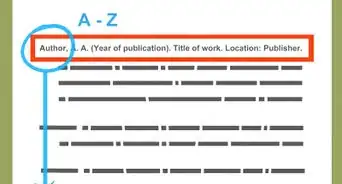This article was co-authored by wikiHow Staff. Our trained team of editors and researchers validate articles for accuracy and comprehensiveness. wikiHow's Content Management Team carefully monitors the work from our editorial staff to ensure that each article is backed by trusted research and meets our high quality standards.
This article has been viewed 154,287 times.
Learn more...
Ibid is an abbreviation of the Latin word ibidem, which literally means “in the same place.” Practically speaking, it means that a citation in a works cited list, endnotes, or footnotes comes from the same work as the citation preceding it. Using this small term can make it easier for your reader to understand which works are cited multiple times in your academic paper or essay. While using ibid is relatively straightforward, there are certain nuances when citing from the same or different pages of the same work.[1]
Steps
Using Ibid for an Immediately Repeated Citation
-
1Write “Ibid.” if the same exact source is cited consecutively. Anytime a single work is immediately and exactly repeated within a single citation or across two citations, you can change the second mention to “Ibid.”[2]
- Let’s say you have a citation “Mike Wilson, A History of Cats (Princeton: Princeton University Press, 2011), 8.” and the citation immediately following is identical. You can change that second citation of the Wilson book simply to read, “Ibid.”
-
2Add a page number after “Ibid.” if only that detail changes. Look for instances in which only the page number differs between consecutive citations of a single source. In those cases, you can change the citation that follows the first citation to read “Ibid., [page number].”[3]
- Let’s say your citation is, “Jen Fox, I Love Siamese Cats (New York: Random House, 2000), 9.” If the citation immediately following cites page 10 of the same book, you can change that second citation to read, “Ibid., 10.”
Advertisement -
3Follow up with more “Ibid.” uses if the single source keeps repeating. Write “Ibid.” if the source following an “Ibid.” citation or an “Ibid., [page number].” citation cites the same page of the same work.[4]
- Let’s say that after your citation of, “Mike Wilson, A History of Cats (Princeton: Princeton University Press, 2011), 8.” there are 3 identical citations all from page 8 of that work. All citations after the first one can be changed to “Ibid.”
- Similarly, if after your “Ibid, 10.” citation of the Fox book, there is another citation to page 10 of the Fox book, you can simply write, “Ibid.”
-
4Use Ibid only to refer to a single work. If, for instance, your footnote 21 and footnote 22 both refer to the Wilson and Fox books, you can't just write "Ibid." to cover both of them in the latter footnote. "Ibid." (with or without a page number notation) can only refer to a single work.[5]
- However, if footnote 21 referred to Wilson and Fox (in that order), and then footnote 22 referred to Fox and Wilson (in that order), you'd start footnote 22 with "Ibid.;" since the Fox book is immediately repeated across consecutive citations.
Inserting Ibid into a Works Cited List
-
1Consult your style guide to create a works cited list. Use the style guide assigned to you by your professor to format a works cited list for your essay. This citation list is typically its own page at the end of the essay. Here you will list all the sources you used to find quotes or other relevant materials presented in your work.[6]
- Depending upon your style guide, a primary citation of a book from your list may look something like this: “Mike Wilson, A History of Cats (Princeton: Princeton University Press, 2011), 8.”
- Examples of common style guides include the Chicago Manual of Style, the Turabian Citation Guide, and the AMA Manual of Style.
- For now, don’t treat sources repeated in the list any differently from one another. Simply focus on creating a proper citation for each work.
-
2Identify primary citations. Look over your list and notice which sources repeat often. Use a highlighter to mark the first time a citation for a specific work appears in your list.[7]
- If a source only appears on your list once, you don’t need to worry about using ibid, as there are no subsequent references.
-
3Use “Ibid.” or “Ibid., [page number].” for immediate repeats after primary citations. Look to the citation immediately after your primary citation. If it’s the same, or the same other than the page number, choose the appropriate version of ibid to use.[8]
- So if you have the citation “Mike Wilson, A History of Cats (Princeton: Princeton University Press, 2011), 8.” and the citation immediately following is the same, you can change that second citation of the Wilson book to, “Ibid.”
- If the citation following that primary citation of the Wilson book is to page 9 of the book instead of page 8, change the second citation to "Ibid., 9.”
-
4Create secondary citations when sources repeat non-consecutively. Look for places where citations to the same source repeat, but with other citations in between them. In these cases, you’ll create a secondary citation for the repeating instances. Depending on your chosen style guide, you'll write a secondary citation as something like the author’s name, a comma, the page number, and then a period.[9]
- Let’s say an unrelated citation appears between a primary reference to page 8 of the Wilson book and a second identical reference to the Wilson book. The second citation would become, “Wilson, 8.”
- Similarly, if the second citation to the Wilson book is on page 9 rather than page 8, the citation would become, “Wilson, 9.”
- Creating a secondary citation is the same whether there is one unrelated citation between the two or several.
-
5Use “Ibid.” when secondary citations immediately repeat. Look over your works cited list for places where secondary citations repeat. Change repeat secondary citations to “Ibid.” for clarity. So, for instance, your list might look like:[10]
- [Smith book primary citation]
- Ibid. [for Smith primary]
- [Wilson book primary citation]
- [Smith book secondary citation]
- Ibid. [for Smith secondary]
- Ibid., 23. [for Smith secondary with different page noted]
Community Q&A
-
QuestionCan I also use Ibid. if the primary and secondary citation are on different pages?
 DonaganTop AnswererYes. See Method 1, Step 2 above.
DonaganTop AnswererYes. See Method 1, Step 2 above. -
QuestionYou have the same citiation coming up at a different point in the text. How do you use ibid?
 GB742Top AnswererIf you're citing the a source non consecutively (e.g. [1] - text A, [2] - text B, [3] - text A) use the short form of the title. Ibidem is only used where the same source is cited consecutively (e.g. [1] - text A, [2] - text A, [3] - text B can be cited as [1] - text A, [2] - Ibid., [3] - text B).
GB742Top AnswererIf you're citing the a source non consecutively (e.g. [1] - text A, [2] - text B, [3] - text A) use the short form of the title. Ibidem is only used where the same source is cited consecutively (e.g. [1] - text A, [2] - text A, [3] - text B can be cited as [1] - text A, [2] - Ibid., [3] - text B). -
QuestionIs "the item cited in the ibid page" correct?
 GB742Top AnswererNo, in this case (i.e. where you have immediately before cited the same page of the same source) you would simply use 'Ibid.'. If you are citing a different page of the same source, the citation would be written as (for example) 'Ibid. p.10'
GB742Top AnswererNo, in this case (i.e. where you have immediately before cited the same page of the same source) you would simply use 'Ibid.'. If you are citing a different page of the same source, the citation would be written as (for example) 'Ibid. p.10'
Warnings
- Do not use ibid at all if a primary citation refers to multiple sources.[11]⧼thumbs_response⧽
- Ibid can be used to refer to websites and online articles as well.⧼thumbs_response⧽
References
- ↑ https://research.wou.edu/c.php?g=551307&p=3785494
- ↑ https://research.wou.edu/c.php?g=551307&p=3785494
- ↑ https://research.wou.edu/c.php?g=551307&p=3785494
- ↑ https://upsem.libguides.com/chicago/ibid
- ↑ https://examples.yourdictionary.com/ibid-examples.html
- ↑ https://upsem.libguides.com/chicago/ibid
- ↑ https://upsem.libguides.com/chicago/ibid
- ↑ https://upsem.libguides.com/chicago/ibid
- ↑ https://www.un.org/dgacm/en/content/editorial-manual/footnotes/chap-05
About This Article
To use the abbreviation Ibid, which comes from the Latin word ibidem, wait until you have the same source cited consecutively. Once you've written out the first citation, place "Ibid" in the space where the second citation would go. If the page number is the only detail that changed between the 2 citations, include a comma and the new page number after "Ibid." If the citation keeps repeating, use "Ibid" to replace any consecutive citations after the first citation until you need to cite a different work. For tips on using Ibid in a works cited list, keep reading!



















-Step-18.webp)


















































